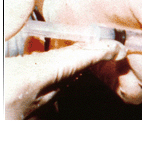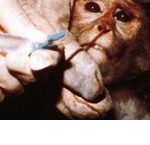Click here to go back.
THE INVALIDITY OF ANIMAL DATA IN DRUG TESTING
The pharmaceutical companies and our government are indeed aware of the potential for inaccurate results when experimenting with animals. This is one of the reasons researchers don’t always rely on them. The other reason is a reluctance to shelve a drug that may market well. So if a drug causes adverse reactions in the animal experiments, it is not automatically tossed aside.
This reveals the vivisection industry’s and our government’s "on the fence" tactics: they firmly endorse animal data as valid and accurate, but when these data lead to mistakes they defend themselves by purporting that animal data are unpredictable and unreliable. Which is it?
Each species has its own metabolic pattern, and no two species are likely to metabolize a medication in the same way.1 Even within a species there exist significant discrepancies that determine how a medication will function; drugs affect females differently from males, children differently from adults, and people differently according to their race.
The animal model has failed to advance research not only because of the diversity between species, but also because of experimental approaches. Animals in laboratories are exposed to enormous doses of a test drug in a short period of time, sometimes continuously, differing greatly from human exposure which occurs at smaller doses intermittently over a long period of time.
When a drug is meant to be taken orally, it may be forced into the animals’ bodies via veins, mucous membranes, etc. So even if we ignore the blatant differences in our bodies, the application differences alone beg the question of validity.
The Pharmaceutical Research and Manufacturers of America estimates that 1% of new drugs tested in animals continues to human clinical trials, and of these, only 1 out of 12 continues past phase I. This is a failure rate of 80%. (The most common reported problem is liver damage.) Of these, only 5% are subsequently approved by the FDA. This convoluted, unproductive system remains unquestioned because the “authorities” have convinced consumers this process protects us.
1. M. Weatherall, Nature (1 April 1982): 387-90.








